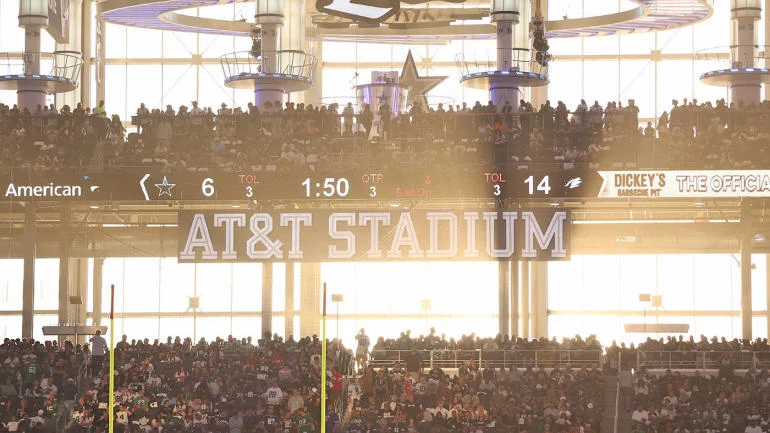
It’s possible that, come the 2027 season, the Tennessee Titans will have at least one of their nine home games be played in the late-afternoon window. A kickoff somewhere in the 3 p.m. Central hour that will conclude around dusk, depending on the time of the year.
The Titans will be breaking in what is today known as New Nissan Stadium, a $2 billion-plus project adjacent to their current digs that will make the East Bank sparkle and (very likely) eventually host a Super Bowl.
The sun will continue its usual disappearing act beneath the earth’s horizon and, at some point, the sunlight would pierce through the windows on the west side of the stadium. The rays would be strong into the new stadium. It would be hard for quarterbacks throwing to that end zone — or pass catchers looking back, depending on who has possession — to see what’s in front of them.
Would. Not will. Because the Titans will use what amounts to black-out shades on the glass so that doesn’t take place.
What the Dallas Cowboys have refused to do for more than a decade, the Tennessee Titans have already prepared to do years from now. The Titans, along with the stadium designers and engineers, did a solar analysis in developmental stages of stadium planning, determining where the sun will be every day of the year and when exactly on certain days this could pose a problem.
The solution: use the retractable shades on the accordion-like glass doors to prevent the sun from leaking onto the field.
Last Sunday afternoon, Cowboys receiver CeeDee Lamb couldn’t find the ball on what should have been an easy touchdown catch against the Philadelphia Eagles as he stared into the star 93 million miles away. After the game he said he was “one thousand percent” in favor of putting up shades.
Cowboys owner Jerry Jones likes it the way it is. AT&T Stadium opened in 2009 with the windows like this, and they’ll be staying that way for the foreseeable future. The stadium can and does erect shades for other events like concerts, but not for the Cowboys.
“My biggest thought when we were building it was, ‘Don’t have it look like it’s not outdoors. Make it look like it’s outdoors,'” Jones said. “That stadium was built to feel like it’s outdoors when you’re indoors, and it was built to have sunlight coming in.”
Jones would go on to say the team knows where the sun will be and that playcallers like Kellen Moore have previously accounted for this.
“That really goes under the category of home-field advantage,” Jones said. “It should be an advantage to the home team, so I don’t want to adjust it for one reason because it is an advantage to us. … That’s our advantage. That should be our advantage. We get to play there more and we get to have it as an advantage. It has been an advantage for us to know where the sun is. I don’t want to change that.”
One question many have had goes to the heart of that competitive advantage. Could the Cowboys put up shades when the sun affects the home team? Or, could the Cowboys pull the shades down only when the sun’s rays are impacting the on-field play?
The answer: No.
CBS Sports obtained a copy of the NFL’s policy on stadium procedures leaguewide, and the league has already considered these questions and more.
“At 90 minutes prior to kickoff, the home club is required to notify the Referee whether the roof, wall, and/or curtains shall be open or closed,” the policy reads. “The opening or closing must be completed no later than 60 minutes prior to kickoff. (The designated position for curtains will remain unchanged for the entire game.)”
So whatever is decided at any stadium 90 minutes before is what will remain throughout the duration of the game. But there can be an exception made, and we saw that two weeks ago at State Farm Stadium.
In Week 9, the Cardinals had to close the roof during the game against the Bears because of hail in the Glendale area. This is allowed in the policy since hail is considered a “hazardous condition.” Once it’s closed, it must remain closed for the remainder of the game.
It’s impossible to imagine sunlight would be considered a hazardous condition, so any temporary shades would be permanent for an entire game.
Back to heliocentrism. Most NFL stadiums have north/south oriented fields, which is why you don’t see the sun being such a factor on the field like with the Cowboys.
The Falcons play in Mercedes-Benz Stadium, a round complex with the field that is oriented east/west. But the windowed side of Atlanta’s stadium is on the east, and the Falcons aren’t waking up to play a game at 8 a.m.
U.S. Bank Stadium has a northwest/southeast orientation, but there have been no complaints about the sun by players in Minnesota. Plus, the translucent roof has a “fritting” that diffuses some of the direct light during Vikings games.
In Tennessee, the Titans determined they had to have an east/west field orientation for their future stadium. Soil testing on the available land in the developing East Bank area showed the organization there was really only one way to position the stadium. Hence, the shades.
For as long as there have been people on earth, there have been attempts to hide from the sun’s rays. Except in Jerry’s World.